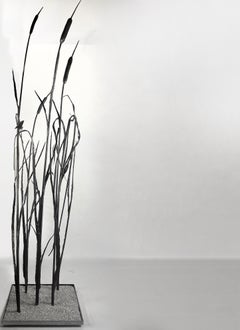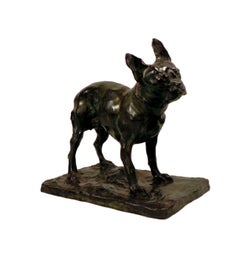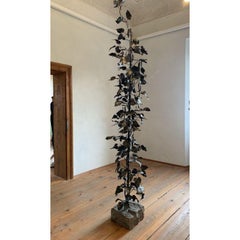Luciano Zanoni Sculptures
Italian, b. 1943
Luciano Zanoni, a blacksmith by profession since his adolescence, was born in Caldes on May 20, 1943. The results of his artistic research, stimulated and encouraged right from the beginning to his friend painter Paolo Vallorz and the intellectual Giovanni Testori, are exhibited for the first time in Milan in December 1979.
He immediately met a broad consensus from critics and public and in the years he arrives to exhibit in almost thirty personal and eighty-three collective exhibitions, among which Milan, Tokyo, Los Angeles, Athens, Strasbourg, Innsbruck, Lyon, Turin, Brescia and Bolzano.
MART of Rovereto has hosted him twice, the most recent exhibition curated by Gabriella Belli.
Critics such as Jean Clair, Raffaele De Grada, Gian Alberto Dell 'Acqua and Giorgio Soavi wrote about him and his work. Jean Clair does not miss the chance to visit his workshop when he passes through Italy.
In 1995 he completed an olive tree for the Bill Gates collection in Seattle (Washington). In the following years he realized some monumental works: in 1996 the "Monument to the Rendeva Cow" in Caderzone (Tn), in 1998 "Hazel tree”, coat of arms of the municipality of Volano and in 2001 "Tree of pomegranate" in Cles, emblem of the Rural Trentine Casse, in 2013 "Big Olive Tree" - which touchs the seven meters high - for a private collector and in 2014 "Big Apple tree" for the Trentino Technological Transformation Center.
Luciano begins his technique of iron forging his son Ivan, who began his artistic activity, independent of his father, starting in 1998. Father and son collaborate for specific projects and share the workshop where they also perform the traditional activity as blacksmiths.to
1
Overall Width
to
Overall Height
to
1
1
1
1
1
1
1
1
214
196
166
142
1
Artist: Luciano Zanoni
Indoor and outdoor wrough iron sculpture - black bamboo reed bed
By Luciano Zanoni
Located in Milan, IT
Contemporary Forged Bamboo Sculpture by Luciano Zanoni
Hand-Forged Steel, Customizable Base – Italy
This striking contemporary sculpture by Italian artist Luciano Zanoni features fi...
Category
2010s Naturalistic Luciano Zanoni Sculptures
Materials
Iron
Related Items
Bronze French Bulldog by Rembrandt Bugatti(1884 - 1916)
By Rembrandt Bugatti
Located in Gent, VOV
Bronze French bulldog
In 1905, Rembrandt Bugatti took his mother's French Bulldog as a model and created this living sculpture, the dog bending its head and seeming to question the ...
Category
Late 19th Century Naturalistic Luciano Zanoni Sculptures
Materials
Bronze
$6,639
H 10.44 in W 10.63 in D 6.5 in
French 19th century Animalier bronze of Two Hares on a naturalistic base
By Alfred Dubucand
Located in Bath, Somerset
19th century bronze group of a standing and sitting hare by French animalier sculptor Alfred Dubucand (1823-1894). Finely detailed bronze with good dark brown patination. Signature '...
Category
Late 19th Century Naturalistic Luciano Zanoni Sculptures
Materials
Bronze
$2,415
H 4.34 in W 3.55 in
Pair of herons in chiseled bronze with green patina, 20th century (1960s)
Located in PARIS, FR
The Herons, pair of chiseled bronze subjects, the body with a green patina and the head with a purple patina, 1960s-1970s. The two herons or storks are presented in different attitud...
Category
1970s Naturalistic Luciano Zanoni Sculptures
Materials
Bronze
$3,142
H 44.89 in W 27.56 in D 23.23 in
Bellota 7
By María José de la Macorra
Located in Mexico City, CDMX
María José de la Macorra (México, D.F., 1964) realizó sus estudios en la Escuela de Cerámica y Porcelana de Toluca, Mokichi Okada Association,...
Category
2010s Naturalistic Luciano Zanoni Sculptures
Materials
Bronze
A late 19th century bronze figure of a dog playing with a ball
By Arthur Waagen
Located in Bath, Somerset
A late 19th century bronze figure of a dog playing with a ball on a naturalistic base. Nice dark rich brown patina with slightly lighter rubbed area to lower side of base. Signed 'Wa...
Category
Late 19th Century Naturalistic Luciano Zanoni Sculptures
Materials
Bronze
A late 19th century bronze animalier figure of a seated hound
By Prince Paul Troubetzkoy
Located in Bath, Somerset
A late 19th century bronze of a hound, seated on a naturalistic base, after Prince Paul Troubetzkoy. Incised to base 'Paolo Troubetzkoy 1893', with a dark brown patina.
Born in 1866...
Category
Late 19th Century Naturalistic Luciano Zanoni Sculptures
Materials
Bronze
$8,714
H 9.45 in W 7.68 in
"SOMEWHERE ELSE #2", Watercolor on Sal Leaf Plate, Black Frame, Green, Red, Tan
By Eva Ennist
Located in Toronto, Ontario
Eva Ennist, a mixed media and fiber artist, travels extensively through the Far East, gathering materials and techniques for her practice. The artwork "SOMETHING ELSE #2" uses materi...
Category
21st Century and Contemporary Naturalistic Luciano Zanoni Sculptures
Materials
Watercolor, Organic Material, Wood, Found Objects, Mixed Media
$900
H 16 in W 16 in D 2 in
Bronze Spanish naturalistic 19th century sculpture of a young boy
Located in Woodbury, CT
An amazing bronze cast of a little 19th-century boy. The quality of the piece is outstanding, as is the color and patination.
There is little known about the painter other than he wo...
Category
1890s Naturalistic Luciano Zanoni Sculptures
Materials
Bronze
$2,062 Sale Price
25% Off
H 12 in W 4 in D 4 in
Two Porcelain Penguins, Bing & Grondahl Manufactory, 20th century
Located in PARIS, FR
Armand PETERSEN (1891-1969) for Bing & Grondahl, Two penguins in polychrome enameled porcelain, each marked under the right paw with the stamp of the Manufacture in green enamel, acc...
Category
Late 20th Century Naturalistic Luciano Zanoni Sculptures
Materials
Porcelain
$4,624
H 10.63 in W 4.38 in
A large late 19th century French animalier bronze of a recumbent greyhound dog
By Christophe Fratin
Located in Bath, Somerset
A large late 19th century bronze figure of a recumbent greyhound after French animalier sculptor Christophe Fratin (1801-1864), with a warm brown patina on a rouge griotte marble base. Signed 'FRATIN' on collar.
Bronze length: 37cm
Base length: 41cm
Bronze height: 18cm
Total height: 22cm
Christophe Fratin was born in Metz in France in 1801. He first studied sculpture under Pioche in Metz under whom he honed his technical skills. He then became a pupil of the painter Theodore Gericault in Paris where he pursued his career as a sculptor.
Fratin first exhibited at the Paris Salon as early as 1831, where he showed ‘Fermer – An English Thoroughbred’. The popularity of Fratin’s sculpture in England had a significant impact on his career. His modelling style reflected his imaginative mind and sense of humour, particularly in his humorous modelling of bears.
Fratin was asked to sculpt life-size monuments for French cities, including his home town of Metz. At the Great Exhibition of 1851 in London he was considered the greatest animalier sculptor of the day. Fratin’s bronzes...
Category
1880s Naturalistic Luciano Zanoni Sculptures
Materials
Bronze
$5,636
H 8.67 in W 16.15 in
DeGroot Brutalist MCM Brass & Metal Owl Sculpture, Signed
Located in Plainview, NY
A brutalist Mid- Century Modern sculpture of an owl by Willem DeGroot ( Netherlands, 20th Century ). The sculpture is made of brass and metal and showing an owl stating on a branch ...
Category
Mid-20th Century Naturalistic Luciano Zanoni Sculptures
Materials
Brass, Copper
$1,200
H 17.25 in W 19 in D 6 in
Horse (mixed media fiber sculpture)
By Siri Hollander
Located in Maricopa, AZ
About the artist :
Siri Hollander’s entire process started from an innate desire to work in large format but being self-taught she had to create her own system through trial and erro...
Category
1990s Naturalistic Luciano Zanoni Sculptures
Materials
Steel
$2,800 Sale Price
30% Off
H 16 in W 18 in D 4 in
Previously Available Items
Unique wrought iron sculpture - wine grape tree natural size - made in Italy
By Luciano Zanoni
Located in Milan, IT
The wrought iron unique piece has been made by the contemporary Italian Maestro Luciano Zanoni.
The sculpture can be disassembled in a few easy shipping delivery pieces.
The sculpt...
Category
2010s Realist Luciano Zanoni Sculptures
Materials
Iron
H 88.98 in W 31.5 in D 30.32 in
Bean Tree, Wrought Iron Sculpture by Luciano Zanoni
By Luciano Zanoni
Located in Milan, IT
Bean tree
Wrought iron, unique proof inches h. 86.6 x w. 23.6 x d. 23.6 - cm h. 220 x w. 60 x d.60
Luciano Zanoni, a blacksmith by profession since hi...
Category
20th Century Luciano Zanoni Sculptures
Materials
Iron
Grape tree, outdoor wrought iron sculpture unique contemporary artwork by Zanoni
By Luciano Zanoni
Located in Milan, IT
The wrought iron unique piece has been made by the contemporary Italian artist Luciano Zanoni. The sculptor flourished as an artist, from his blacksmith career when the Italian famou...
Category
2010s Realist Luciano Zanoni Sculptures
Materials
Iron
Luciano ZanoniGrape tree, outdoor wrought iron sculpture unique contemporary artwork by Zanoni, 2018
H 88.98 in W 31.5 in D 30.32 in
Luciano Zanoni sculptures for sale on 1stDibs.
Find a wide variety of authentic Luciano Zanoni sculptures available for sale on 1stDibs. You can also browse by medium to find art by Luciano Zanoni in iron, metal and more. Not every interior allows for large Luciano Zanoni sculptures, so small editions measuring 20 inches across are available. Customers who are interested in this artist might also find the work of Ivan Zanoni, Peter Brooke, and Christopher Slatoff. Luciano Zanoni sculptures prices can differ depending upon medium, time period and other attributes. On 1stDibs, the price for these items starts at $8,817 and tops out at $8,817, while the average work can sell for $8,817.


